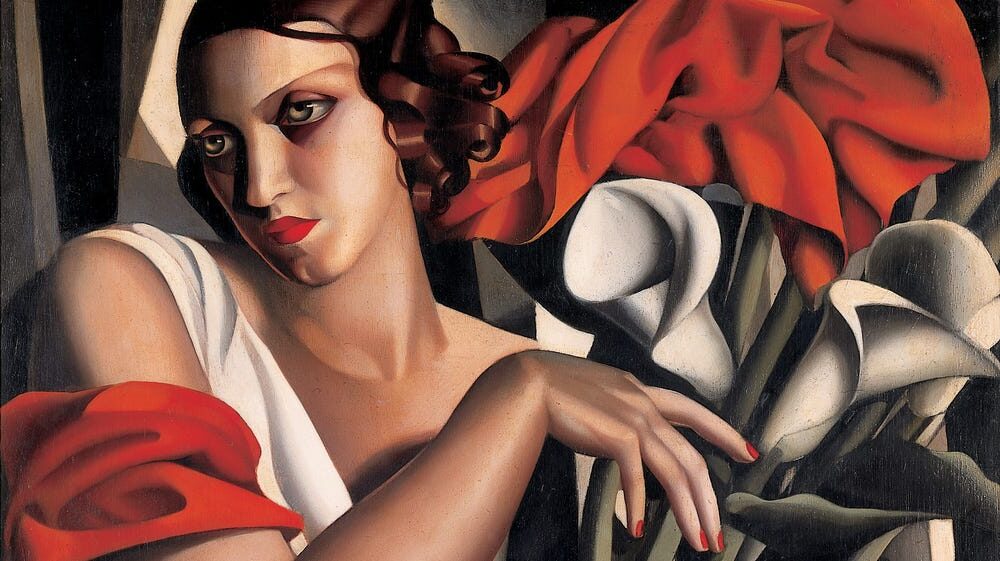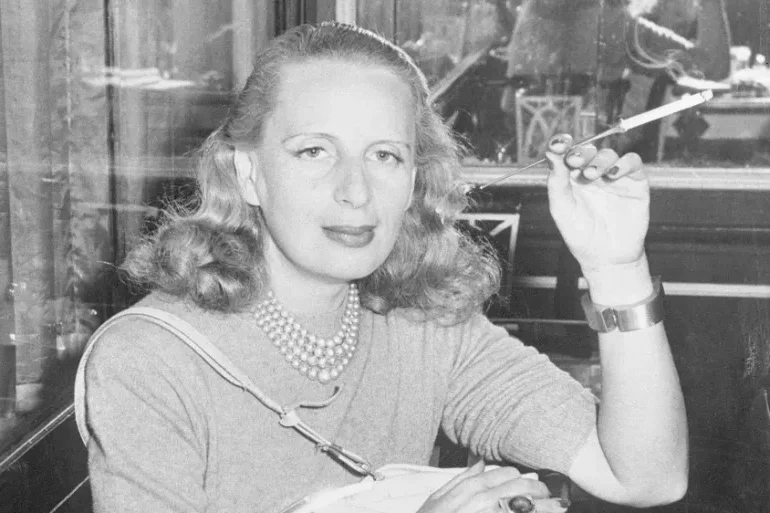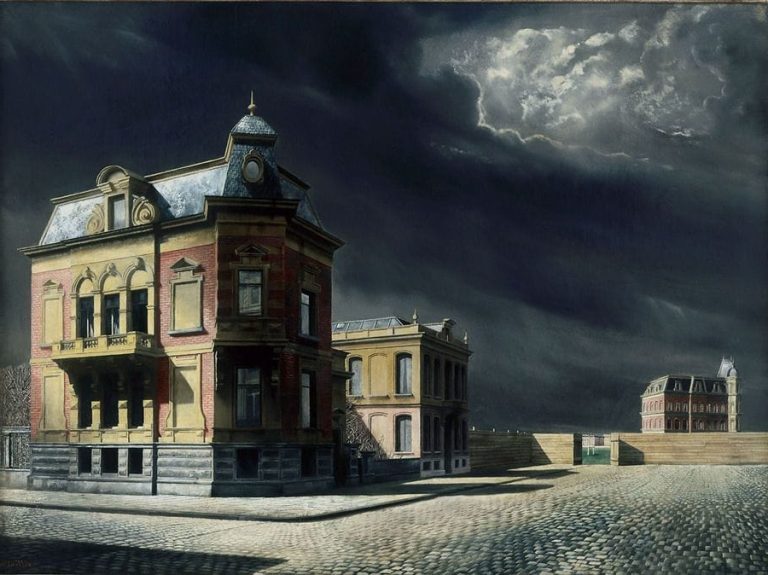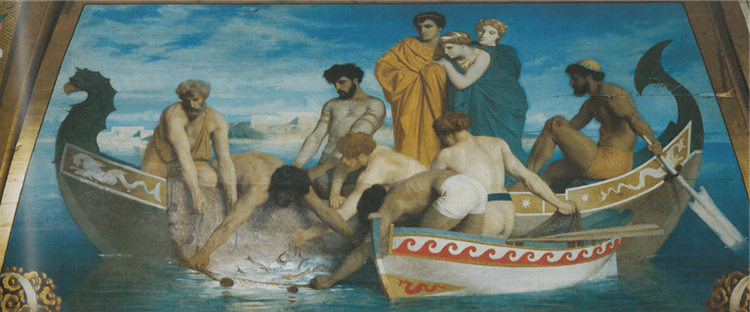Tamara de Lempicka Painter: Art Deco Pioneer of the 1920s
Born: 16 June 1894, Warsaw, Congress Poland
Death: 18 March 1980, Cuernavaca, Mexico
Art Movement: Art Deco
Nationality: Polish
Teachers: Maurice Denis and André Lhote
Institution: Saint Petersburg Academy of Arts and Académie de la Grande Chaumière
Tamara de Lempicka Painter: Art Deco Pioneer of the 1920s
Life and Career of Tamara de Lempicka
Tamara de Lempicka lived a vibrant life that spanned Poland, Russia, France, and the United States. Her career flourished during the Art Deco period, with her distinct style capturing the essence of the modern woman in the early 20th century.
Early Life and Russian Revolution
Tamara Łempicka (later known as de Lempicka) was born on May 16, 1898, in Warsaw, Poland. She came from a wealthy family and spent her youth between Warsaw and St. Petersburg, where she was exposed to fine art and high society.
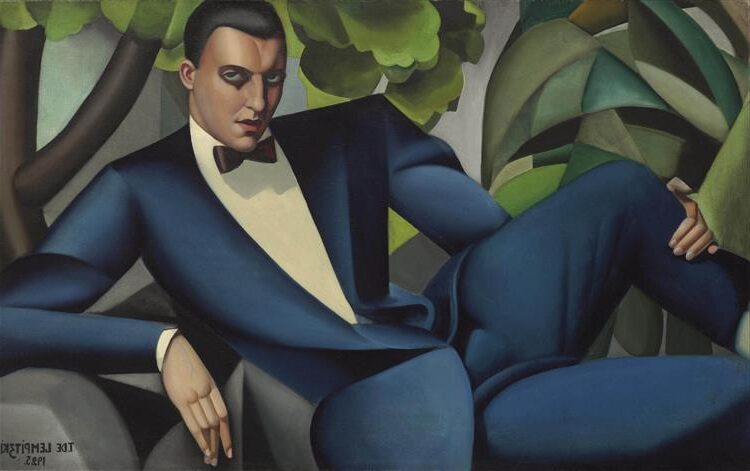
Portrait of the Marquis d’Afflito 1925 by Tamara de Lempicka
In 1916, she married lawyer Tadeusz Łempicki in St. Petersburg. Their lives changed dramatically with the outbreak of the Russian Revolution in 1917. Tadeusz was arrested by Bolsheviks, forcing Tamara to use her connections to secure his release.
The couple fled the revolution, leaving their comfortable lifestyle behind. This period of upheaval would deeply influence Lempicka’s later work, particularly her portrayal of strong, independent women.
Paris in the Roaring Twenties
After escaping Russia, de Lempicka and her husband settled in Paris in 1918. Financial necessity pushed her to begin painting professionally. She studied art under Maurice Denis and André Lhote, developing her unique style that combined elements of cubism with neoclassical techniques.
The 1920s Paris art scene embraced her work. She became known for her polished Art Deco portraits of aristocrats and wealthy clients. Her paintings featured bold colors, sharp angles, and stylized figures that captured the spirit of the era.
De Lempicka embodied the liberated woman of the 1920s—independent, fashionable, and sexually free. Her personal life was as colorful as her canvases, with numerous affairs with both men and women. Her portraits of this period showcase elegant, modern women with a distinct sensuality.
Transition to America and Later Years
As political tensions rose in Europe prior to World War II, de Lempicka moved to the United States in 1939. She settled first in New York City, where she continued to paint portraits of the wealthy elite.

Woman in a Yellow Dress 1929 by Tamara de Lempicka
Her Art Deco style fell out of fashion in the 1940s and 1950s, causing a decline in commissions. Undeterred, she experimented with abstract styles but never achieved the same recognition as with her earlier work.
In 1978, she moved to Cuernavaca, Mexico, where she lived until her death on March 18, 1980. Following her wishes, her ashes were scattered over the volcano Popocatépetl. Though her popularity waned during her later years, her work experienced a revival in the 1980s, cementing her legacy as a pioneering female artist.
Artistic Style and Notable Works
Tamara de Lempicka developed a distinctive style that blended Art Deco aesthetics with elements of cubism and classical art, creating elegant and provocative images that captured the spirit of the 1920s and 1930s.
Art Deco and its Influence
Lempicka’s work embodied the Art Deco movement with its sleek lines, bold geometric shapes, and metallic colors. After studying with André Lhote in Paris, she incorporated cubist techniques while maintaining a polished finish that distinguished her from other avant-garde artists. Her paintings featured sharp edges, tubular forms, and a distinctive palette of bright, bold colors against cool backgrounds.
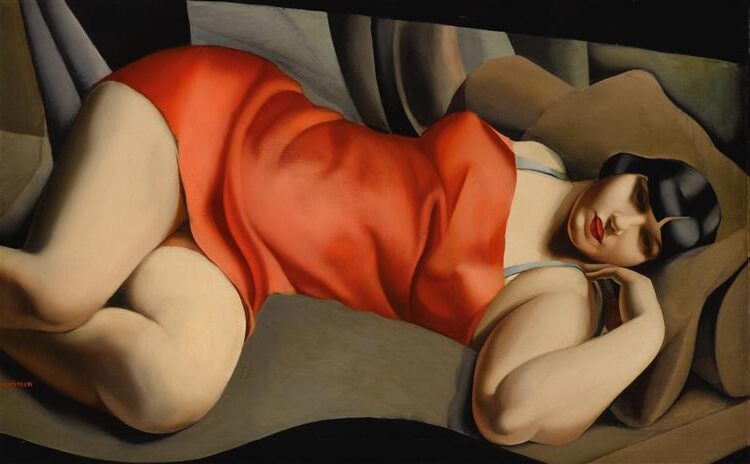
Woman in Red (Portrait of Mrs. Bush) 1927 by Tamara de Lempicka
Critics called Lempicka’s work “soft cubism” or “neo-cubism,” making her work more accessible while still appearing modern and sophisticated. The influence of Italian Renaissance masters is evident in her precise draftsmanship and attention to form.
Her technique included using thin glazes of paint applied with both brushes and palette knives to create her signature smooth, almost porcelain-like surfaces that reflected the machine age aesthetic.
Portraiture and Iconic Subjects
Lempicka gained fame through her portraits of aristocrats, socialites, and fellow artists. These subjects were typically depicted as strong, independent, and sexually confident figures. Her most famous work, “Auto-Portrait” (1929), shows the artist in a green Bugatti, embodying the modern, liberated woman of the era.
“The Musician” stands out as another iconic painting, featuring bold contrasts and her trademark sculptural treatment of the human form. Lempicka often portrayed women with knowing gazes directed at the viewer, challenging traditional passive female representation.
Her subjects frequently possessed elongated bodies, angular faces, and perfectly manicured appearances. Lempicka infused her portraits with eroticism and sensuality that appealed to both male and female viewers, particularly resonating with lesbian and bisexual women of her time.
Evolution Beyond Art Deco
As her career progressed, Lempicka’s style evolved beyond pure Art Deco aesthetics. During the 1930s, she began incorporating elements of neo-classicism into her work, creating more traditional compositions while maintaining her distinctive polished technique.

Still Life with Grapes by Tamara de Lempicka
After moving to America and later Mexico, Lempicka experimented with religious themes. Her interpretations of “Madonna and Child” and “Adam and Eve” demonstrated her ability to blend sacred subjects with her modern sensibility.
By the 1940s, she began exploring abstraction, though with limited commercial success. This period showed her attempting to adapt to changing artistic trends while preserving her unique vision.
Legacy and Influence
Tamara de Lempicka left a lasting mark on art history as the queen of Art Deco painting. Born in 1898 and passing away in 1980, her work bridges traditional techniques with modern sensibilities.
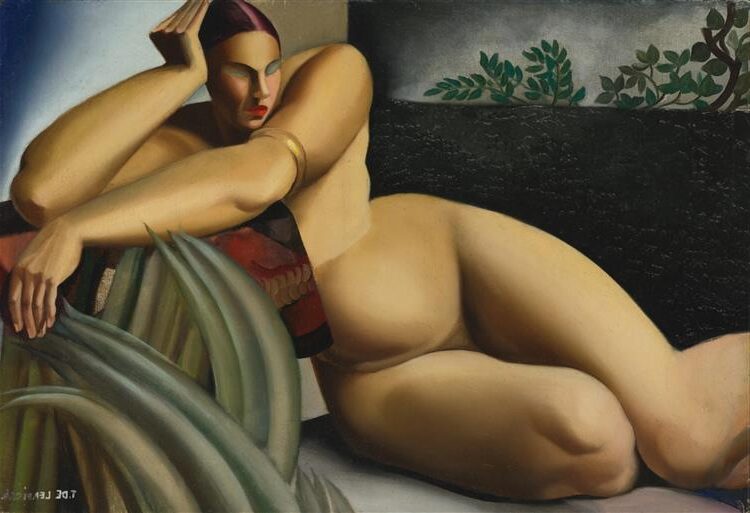
Nude on a Terrace by Tamara de Lempicka
Her paintings gained international recognition at the 1925 International Exhibition of Modern Decorative and Industrial Arts in Paris, establishing her signature style that would influence generations of artists.
Lempicka’s depictions of the Modern Woman challenged conventions of her time. Works like “Group of Four Nudes” and “Kizette in Pink” (a portrait of her daughter) showcased her technical skill and progressive vision.
After fleeing Europe during World War II, Lempicka moved between New York and various American cities, spreading her artistic influence beyond European borders.
Her life paralleled the tumultuous changes of the 20th century. From her marriage to Tadeusz Lempicki to her later relationship with Baron Raoul Kuffner, her personal journey reflected the evolving concept of Self-Determination for women.
While influenced by Art Nouveau and artists like Maurice Denis of the Nabis movement, Lempicka created something entirely her own – a style that captured the glamour and energy of the Roaring Twenties.
Today, her work appears in major museums and private collections worldwide. Fashion designers, photographers, and contemporary artists continue drawing inspiration from her bold colors, clean lines, and striking compositions.
Lempicka’s paintings have been featured in publications like Cosmopolitan, cementing her place in popular culture as an icon of feminine strength and artistic innovation.
Frequently Asked Questions
Tamara de Lempicka’s artistic journey sparked many questions about her distinctive style, personal influences, and lasting impact on the art world. Her bold approach to Art Deco and portraiture continues to fascinate art historians and collectors alike.
What art movement is Tamara de Lempicka associated with?
Tamara de Lempicka is most strongly associated with the Art Deco movement. Her work embodied the sleek, bold aesthetic that defined this style during the 1920s and 1930s.
She combined elements of Cubism and Neoclassicism to create her unique interpretation of Art Deco. Her paintings featured geometric precision, clean lines, and a polished finish that reflected the machine age’s influence.
Lempicka’s style stood out for its modern sensibility while maintaining classical proportions and techniques. Art historians often describe her as the “Baroness with a Brush” who perfected Art Deco painting.
How did Tamara de Lempicka’s style evolve throughout her career?
Lempicka’s early work showed influences from Cubism after studying in Paris. She quickly developed her signature style with sharp angles, bold forms, and luminous colors that defined her Art Deco period.
During the 1930s, her technique became even more refined and polished. Her brushwork grew increasingly precise, and her color palette evolved to include cooler tones with metallic qualities.
After moving to America in the 1940s, her style shifted as Art Deco fell out of fashion. She experimented briefly with abstract styles but eventually returned to a softer, more romantic version of her earlier work that was less well-received.
What are some of Tamara de Lempicka’s most iconic works?
“Auto-Portrait” (1929) stands as perhaps her most famous work. In this self-portrait, she depicts herself in a green Bugatti, embodying the independent, modern woman of the era.
“The Beautiful Rafaela” series showcases her distinctive approach to the female form with bold sensuality and geometric precision. These works highlight her technical mastery and unique perspective.
“Portrait of Marjorie Ferry” (1932) exemplifies her ability to capture glamour through her signature style. “Adam and Eve” (1932) demonstrates her approach to classical subjects with a modern Art Deco interpretation.
How did Tamara de Lempicka’s background and personal life influence her artwork?
Born to a wealthy Polish family in 1898, Lempicka’s privileged upbringing exposed her to high society and the arts from an early age. This foundation shaped her fascination with elegance and luxury.
Her experience as a refugee fleeing the Russian Revolution influenced her determination to succeed independently. This drive manifested in both her ambitious career pursuit and the confident female figures in her paintings.
Lempicka’s bisexuality and bohemian lifestyle in Paris informed her artistic vision. Her personal experiences in high society circles gave her access to the wealthy clientele she painted while allowing her to maintain her unconventional personal freedom.
In what ways has Tamara de Lempicka’s work impacted modern art and contemporary artists?
Lempicka pioneered a distinctive female gaze in portraiture that challenged male-dominated perspectives. Her strong, independent female subjects influenced later feminist art approaches.
Her technical precision and distinctive style created a visual language that continues to inspire fashion photography, graphic design, and illustration. Contemporary artists frequently reference her color palette and geometric approach.
Her work bridged fine art and commercial aesthetics in ways that anticipated pop art and modern advertising. This crossover appeal helps explain why her images remain instantly recognizable and frequently reproduced today.
What led to the revival of interest in Tamara de Lempicka’s artwork in recent decades?
The 1970s brought renewed appreciation for Art Deco aesthetics, sparking fresh interest in Lempicka’s work. A major retrospective in 1973 reintroduced her paintings to the art world after years of neglect.
Celebrity collectors like Madonna and Jack Nicholson helped popularize her work in the 1980s and 1990s. Madonna’s music videos notably featured Lempicka’s paintings, introducing them to new generations.
Auction sales have consistently broken records since the early 2000s. Her paintings now regularly sell for millions, confirming her status as one of the most valuable female artists of the 20th century.

